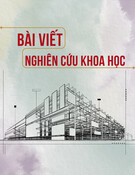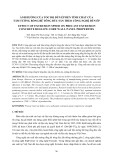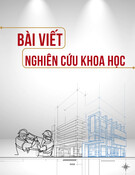
Journal of Science and Technique - ISSN 1859-0209
185
EXPERIMENTAL STUDY ON THE FLEXURAL BEHAVIOR
OF TRC-STRENGTHENED REINFORCED CONCRETE BEAMS
Thi Thu Nga Nguyen1, Ngoc Quang Vu1, Viet Chinh Mai1,*, Trung Kien Nguyen2
1Institute of Techniques for Special Construction, Le Quy Don Technical University
2Ministry's Office, Ministry of Construction
Abstract
This article presents the experimental results on the flexural behavior of reinforced concrete
(RC) beams strengthened with textile-reinforced concrete (TRC). Four RC beams were made
of B22.5 grade concrete, and the TRC strengthening layer utilized Sigratex Grid 350 textile,
with fine-grained concrete Sikagrout 214-11 serving as the binder. The reinforcement layer was
applied using a grooving technique. The four-point bending test was conducted to evaluate the
improvements in load-bearing capacity and deformation of the beams after strengthening. The
results indicated that the strengthened beams exhibited a 36.2% higher load-bearing capacity
and a 13.5% increase in mid-span deflection compared to un-strengthened beams. However,
the occurrence of debonding in the reinforcing layer reduced the strengthening effectiveness.
To ensure the efficiency of flexural strengthening with TRC, attention should be given to the
adhesion of the fine-grained concrete layer and additional reinforcement of the compression
zone. These findings provide a basis for the practical application of TRC in enhancing RC
structures, ensuring both safety and performance.
Keywords: Textile reinforced concrete; strengthened reinforced concrete beam; four-point bending
test; grooving technique.
1. Introduction
Textile Reinforced Concrete (TRC) primarily consists of fine-grained concrete and
high-strength textile reinforcement, such as carbon or glass fiber. TRC exhibits superior
mechanical properties, high durability, and better corrosion resistance compared to
conventional concrete. TRC is used as a structural material and as a reinforcement to
enhance load-bearing capacity and extend the service life of structures [1, 2]. It is an
effective solution for improving the load-carrying capacity of reinforced concrete (RC)
beams, significantly increasing strength, initial cracking load, and ultimate load capacity,
enhancing ductility, and reducing environmental deterioration [3-5].
Experimental and numerical studies on flexural-strengthened beams have shown that
ensuring proper bonding between the TRC layer and the existing concrete is critical for
effective reinforcement. The adhesion between the fine-grained concrete layer and the old
* Corresponding author, email: maivietchinh@lqdtu.edu.vn
DOI: 10.56651/lqdtu.jst.v7.n02.885.sce






























